Simran Khanuja
Towards Automatic Evaluation for Image Transcreation
Dec 18, 2024



Abstract:Beyond conventional paradigms of translating speech and text, recently, there has been interest in automated transcreation of images to facilitate localization of visual content across different cultures. Attempts to define this as a formal Machine Learning (ML) problem have been impeded by the lack of automatic evaluation mechanisms, with previous work relying solely on human evaluation. In this paper, we seek to close this gap by proposing a suite of automatic evaluation metrics inspired by machine translation (MT) metrics, categorized into: a) Object-based, b) Embedding-based, and c) VLM-based. Drawing on theories from translation studies and real-world transcreation practices, we identify three critical dimensions of image transcreation: cultural relevance, semantic equivalence and visual similarity, and design our metrics to evaluate systems along these axes. Our results show that proprietary VLMs best identify cultural relevance and semantic equivalence, while vision-encoder representations are adept at measuring visual similarity. Meta-evaluation across 7 countries shows our metrics agree strongly with human ratings, with average segment-level correlations ranging from 0.55-0.87. Finally, through a discussion of the merits and demerits of each metric, we offer a robust framework for automated image transcreation evaluation, grounded in both theoretical foundations and practical application. Our code can be found here: https://github.com/simran-khanuja/automatic-eval-transcreation
Pangea: A Fully Open Multilingual Multimodal LLM for 39 Languages
Oct 21, 2024Abstract:Despite recent advances in multimodal large language models (MLLMs), their development has predominantly focused on English- and western-centric datasets and tasks, leaving most of the world's languages and diverse cultural contexts underrepresented. This paper introduces Pangea, a multilingual multimodal LLM trained on PangeaIns, a diverse 6M instruction dataset spanning 39 languages. PangeaIns features: 1) high-quality English instructions, 2) carefully machine-translated instructions, and 3) culturally relevant multimodal tasks to ensure cross-cultural coverage. To rigorously assess models' capabilities, we introduce PangeaBench, a holistic evaluation suite encompassing 14 datasets covering 47 languages. Results show that Pangea significantly outperforms existing open-source models in multilingual settings and diverse cultural contexts. Ablation studies further reveal the importance of English data proportions, language popularity, and the number of multimodal training samples on overall performance. We fully open-source our data, code, and trained checkpoints, to facilitate the development of inclusive and robust multilingual MLLMs, promoting equity and accessibility across a broader linguistic and cultural spectrum.
NaturalBench: Evaluating Vision-Language Models on Natural Adversarial Samples
Oct 18, 2024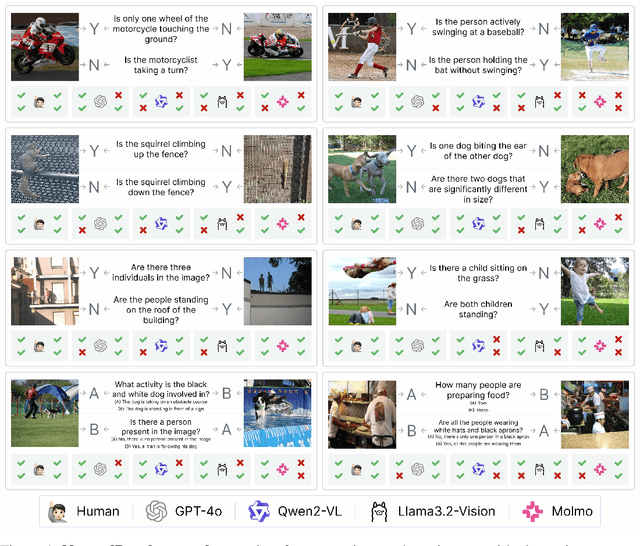
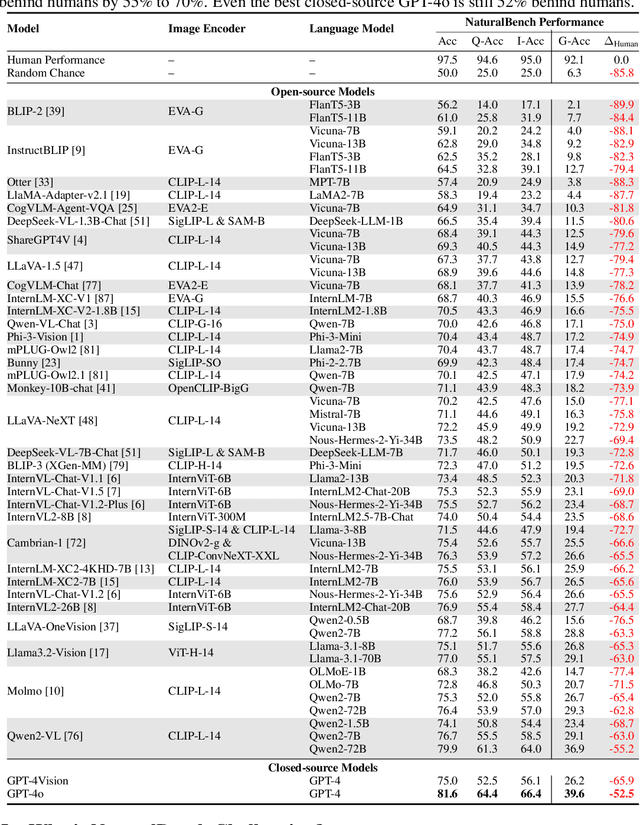
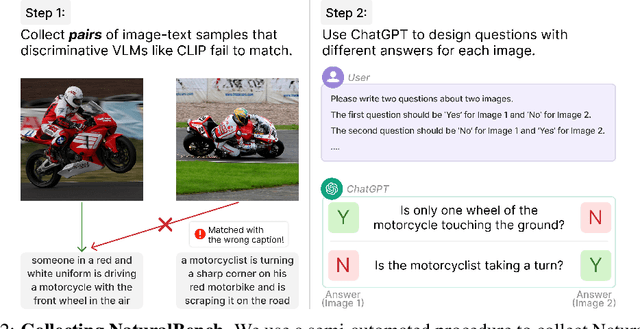

Abstract:Vision-language models (VLMs) have made significant progress in recent visual-question-answering (VQA) benchmarks that evaluate complex visio-linguistic reasoning. However, are these models truly effective? In this work, we show that VLMs still struggle with natural images and questions that humans can easily answer, which we term natural adversarial samples. We also find it surprisingly easy to generate these VQA samples from natural image-text corpora using off-the-shelf models like CLIP and ChatGPT. We propose a semi-automated approach to collect a new benchmark, NaturalBench, for reliably evaluating VLMs with 10,000 human-verified VQA samples. Crucially, we adopt a $\textbf{vision-centric}$ design by pairing each question with two images that yield different answers, preventing blind solutions from answering without using the images. This makes NaturalBench more challenging than previous benchmarks that can be solved with commonsense priors. We evaluate 53 state-of-the-art VLMs on NaturalBench, showing that models like LLaVA-OneVision, Cambrian-1, Llama3.2-Vision, Molmo, Qwen2-VL, and even GPT-4o lag 50%-70% behind human performance (over 90%). We analyze why NaturalBench is hard from two angles: (1) Compositionality: Solving NaturalBench requires diverse visio-linguistic skills, including understanding attribute bindings, object relationships, and advanced reasoning like logic and counting. To this end, unlike prior work that uses a single tag per sample, we tag each NaturalBench sample with 1 to 8 skill tags for fine-grained evaluation. (2) Biases: NaturalBench exposes severe biases in VLMs, as models often choose the same answer regardless of the image. Lastly, we apply our benchmark curation method to diverse data sources, including long captions (over 100 words) and non-English languages like Chinese and Hindi, highlighting its potential for dynamic evaluations of VLMs.
An image speaks a thousand words, but can everyone listen? On translating images for cultural relevance
Apr 01, 2024



Abstract:Given the rise of multimedia content, human translators increasingly focus on culturally adapting not only words but also other modalities such as images to convey the same meaning. While several applications stand to benefit from this, machine translation systems remain confined to dealing with language in speech and text. In this work, we take a first step towards translating images to make them culturally relevant. First, we build three pipelines comprising state-of-the-art generative models to do the task. Next, we build a two-part evaluation dataset: i) concept: comprising 600 images that are cross-culturally coherent, focusing on a single concept per image, and ii) application: comprising 100 images curated from real-world applications. We conduct a multi-faceted human evaluation of translated images to assess for cultural relevance and meaning preservation. We find that as of today, image-editing models fail at this task, but can be improved by leveraging LLMs and retrievers in the loop. Best pipelines can only translate 5% of images for some countries in the easier concept dataset and no translation is successful for some countries in the application dataset, highlighting the challenging nature of the task. Our code and data is released here: https://github.com/simran-khanuja/image-transcreation.
What Is Missing in Multilingual Visual Reasoning and How to Fix It
Mar 03, 2024



Abstract:NLP models today strive for supporting multiple languages and modalities, improving accessibility for diverse users. In this paper, we evaluate their multilingual, multimodal capabilities by testing on a visual reasoning task. We observe that proprietary systems like GPT-4V obtain the best performance on this task now, but open models lag in comparison. Surprisingly, GPT-4V exhibits similar performance between English and other languages, indicating the potential for equitable system development across languages. Our analysis on model failures reveals three key aspects that make this task challenging: multilinguality, complex reasoning, and multimodality. To address these challenges, we propose three targeted interventions including a translate-test approach to tackle multilinguality, a visual programming approach to break down complex reasoning, and a novel method that leverages image captioning to address multimodality. Our interventions achieve the best open performance on this task in a zero-shot setting, boosting open model LLaVA by 13.4%, while also minorly improving GPT-4V's performance.
DeMuX: Data-efficient Multilingual Learning
Nov 10, 2023



Abstract:We consider the task of optimally fine-tuning pre-trained multilingual models, given small amounts of unlabelled target data and an annotation budget. In this paper, we introduce DEMUX, a framework that prescribes the exact data-points to label from vast amounts of unlabelled multilingual data, having unknown degrees of overlap with the target set. Unlike most prior works, our end-to-end framework is language-agnostic, accounts for model representations, and supports multilingual target configurations. Our active learning strategies rely upon distance and uncertainty measures to select task-specific neighbors that are most informative to label, given a model. DeMuX outperforms strong baselines in 84% of the test cases, in the zero-shot setting of disjoint source and target language sets (including multilingual target pools), across three models and four tasks. Notably, in low-budget settings (5-100 examples), we observe gains of up to 8-11 F1 points for token-level tasks, and 2-5 F1 for complex tasks. Our code is released here: https://github.com/simran-khanuja/demux.
Multi-lingual and Multi-cultural Figurative Language Understanding
May 25, 2023Abstract:Figurative language permeates human communication, but at the same time is relatively understudied in NLP. Datasets have been created in English to accelerate progress towards measuring and improving figurative language processing in language models (LMs). However, the use of figurative language is an expression of our cultural and societal experiences, making it difficult for these phrases to be universally applicable. In this work, we create a figurative language inference dataset, \datasetname, for seven diverse languages associated with a variety of cultures: Hindi, Indonesian, Javanese, Kannada, Sundanese, Swahili and Yoruba. Our dataset reveals that each language relies on cultural and regional concepts for figurative expressions, with the highest overlap between languages originating from the same region. We assess multilingual LMs' abilities to interpret figurative language in zero-shot and few-shot settings. All languages exhibit a significant deficiency compared to English, with variations in performance reflecting the availability of pre-training and fine-tuning data, emphasizing the need for LMs to be exposed to a broader range of linguistic and cultural variation during training.
GlobalBench: A Benchmark for Global Progress in Natural Language Processing
May 24, 2023



Abstract:Despite the major advances in NLP, significant disparities in NLP system performance across languages still exist. Arguably, these are due to uneven resource allocation and sub-optimal incentives to work on less resourced languages. To track and further incentivize the global development of equitable language technology, we introduce GlobalBench. Prior multilingual benchmarks are static and have focused on a limited number of tasks and languages. In contrast, GlobalBench is an ever-expanding collection that aims to dynamically track progress on all NLP datasets in all languages. Rather than solely measuring accuracy, GlobalBench also tracks the estimated per-speaker utility and equity of technology across all languages, providing a multi-faceted view of how language technology is serving people of the world. Furthermore, GlobalBench is designed to identify the most under-served languages, and rewards research efforts directed towards those languages. At present, the most under-served languages are the ones with a relatively high population, but nonetheless overlooked by composite multilingual benchmarks (like Punjabi, Portuguese, and Wu Chinese). Currently, GlobalBench covers 966 datasets in 190 languages, and has 1,128 system submissions spanning 62 languages.
Evaluating Inclusivity, Equity, and Accessibility of NLP Technology: A Case Study for Indian Languages
May 25, 2022



Abstract:In order for NLP technology to be widely applicable and useful, it needs to be inclusive of users across the world's languages, equitable, i.e., not unduly biased towards any particular language, and accessible to users, particularly in low-resource settings where compute constraints are common. In this paper, we propose an evaluation paradigm that assesses NLP technologies across all three dimensions, hence quantifying the diversity of users they can serve. While inclusion and accessibility have received attention in recent literature, equity is currently unexplored. We propose to address this gap using the Gini coefficient, a well-established metric used for estimating societal wealth inequality. Using our paradigm, we highlight the distressed state of diversity of current technologies for Indian (IN) languages, motivated by their linguistic diversity and large, varied speaker population. To improve upon these metrics, we demonstrate the importance of region-specific choices in model building and dataset creation and also propose a novel approach to optimal resource allocation during fine-tuning. Finally, we discuss steps that must be taken to mitigate these biases and call upon the community to incorporate our evaluation paradigm when building linguistically diverse technologies.
FLEURS: Few-shot Learning Evaluation of Universal Representations of Speech
May 25, 2022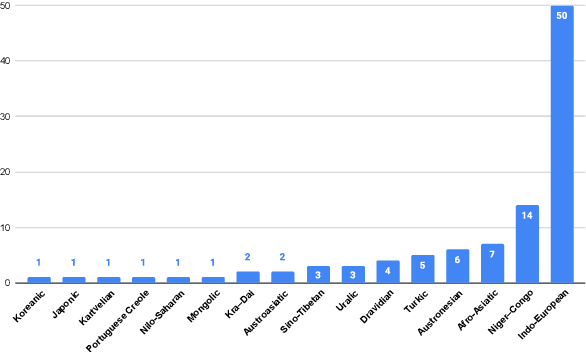

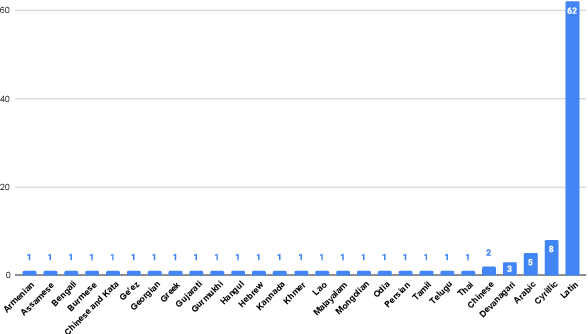

Abstract:We introduce FLEURS, the Few-shot Learning Evaluation of Universal Representations of Speech benchmark. FLEURS is an n-way parallel speech dataset in 102 languages built on top of the machine translation FLoRes-101 benchmark, with approximately 12 hours of speech supervision per language. FLEURS can be used for a variety of speech tasks, including Automatic Speech Recognition (ASR), Speech Language Identification (Speech LangID), Translation and Retrieval. In this paper, we provide baselines for the tasks based on multilingual pre-trained models like mSLAM. The goal of FLEURS is to enable speech technology in more languages and catalyze research in low-resource speech understanding.
 Add to Chrome
Add to Chrome Add to Firefox
Add to Firefox Add to Edge
Add to Edge